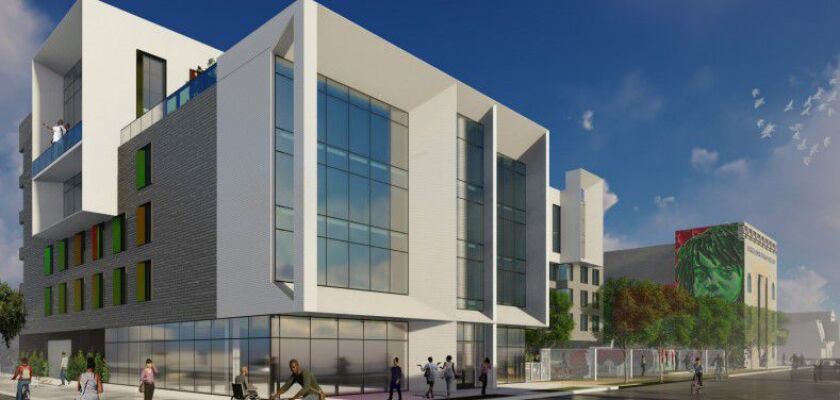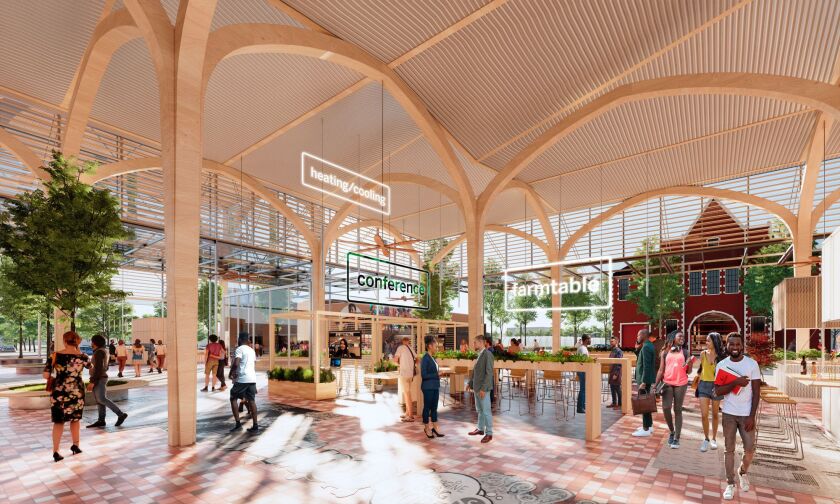Three areas targeted for improvement under Mayor Lori Lightfoot’s Invest South/West program will get an estimated $65 million in commercial development under plans announced Monday.
The projects are supposed to revitalize commercial stretches of Auburn Gresham, Austin and Englewood. The city’s planning department, after sessions with community groups, selected the winners from among 12 development teams who answered a call for proposals made last year.
The favored projects include 56 units of affordable housing with a playground and private gardens in Auburn Gresham; a blues museum and commercial and residential development that includes a landmark building in Austin; and a new phase of the Englewood Square Shopping Center at 63rd and Halsted streets that would turn an old firehouse into a commercial kitchen and event space.
“Do you feel the buzz and excitement in this room? I do. That tells me this is a new day,” a triumphant Lightfoot told the crowd gathered for the announcement at the Kehrein Center for the Arts, 5628 W. Washington Blvd., in Austin.
Factors an evaluation committee used in picking the winners included design quality, financial viability and diverse ownership of the development teams. Officials said it was the first time proposals have been reviewed with an explicit goal of encouraging minority-owned firms.
Each project will require zoning changes subject to City Council approval. If there are no hitches, construction could begin by the end of the year, officials said.
The development teams selected:
• In Auburn Gresham at 838 W. 79th St., Evergreen Real Estate Group and Imagine Group’s plan for affordable housing and open space involves construction of 77,150 square feet to complement a healthy lifestyle hub across the street.
• In Austin at 5200 W. Chicago Ave., Heartland Housing Alliance and Oak Park Regional Housing’s plan includes a multistory rental building and public plaza with a renovation of the former Laramie State Bank into a blues museum, bank branch, café and business incubator.
• In Englewood on the 800 block of West 63rd Parkway, McLaurin Development and Farpoint Development’s plans include repurposing the old firehouse as a commercial kitchen with a business incubator and a nearby event space in a later phase.
The properties are city-owned or in private hands. The proposals were developed in consultation with the owners.
The projects are part of the Invest South/West program. Eighteen months ago, Lightfoot targeted 10 inner-city neighborhoods for an unprecedented $250 million in city investment and $500 million more from other government agencies over a three-year period.
The city has solicited similar development ideas for sites in Bronzeville, New City-Back of the Yards, North Lawndale and South Chicago. Responses are due March 30.
Although the coronavirus pandemic has had a chilling effect on downtown development, Invest South/West is forging ahead, albeit a bit slower than the mayor would like.
To date, $70 million in city dollars has attracted another $300 million in private investment, Lightfoot said.
Even more important than the infusion of capital is the way the city went about choosing the three projects in Auburn Gresham, Austin and Englewood. It was done from the ground up — by listening to “community partners” about what they wanted and needed in their neighborhoods and working with them, in some cases, on plans they had already devised but lacked the capital or expertise to bring to life.
“This is not a circumstance where the fifth floor [mayor’s office] conceives of an idea, we check the box on community engagement, then do what we were planning to do in the first place. No. This has been very, very different. ... We came to the table to start by listening to community voices,” Lightfoot said.
“Another unique and historic aspect of these investments was our emphasis on community wealth building. … We required the applicants to articulate concrete plans for creating economic opportunity for people in the communities they wanted to build in. and that was a significant factor in the decision-making. ... We also made sure that each of these teams …had people who looked like the communities they served. This, folks, is how you create tangible, transformative change.”
Lightfoot noted that when she announced Invest South/West there were “murmurs” from people who were “fearful” that she “didn’t understand development” and was neglecting the economic engine that is downtown.
“Let me say this to investors and developers and skeptics. Take heed. In Chicago, we have a new way of doing business. It’s called equitable, inclusive growth in neighborhoods that lifts everybody up,” she said.
“I am unapologetic about building wealth. ... Chicago is open for business for everyone and not just a clouted few.”







